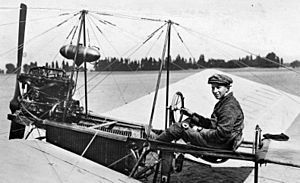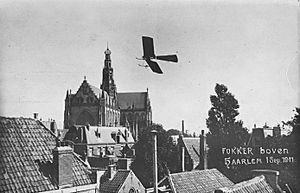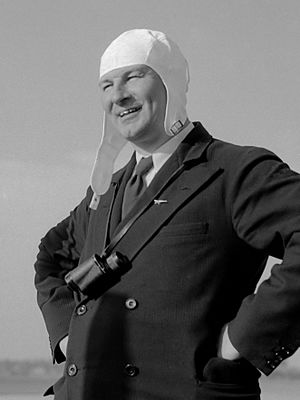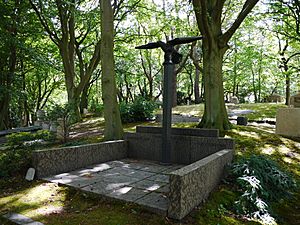Anthony Fokker facts for kids
Quick facts for kids
Anthony Fokker
|
|
|---|---|

Fokker in 1912
|
|
| Born |
Anton Herman Gerard Fokker
6 April 1890 |
| Died | 23 December 1939 (aged 49) Murray Hill Hospital, New York City, United States
|
| Nationality | Dutch, German, US |
| Occupation | Aircraft manufacturer |
| Spouse(s) | Sophie Marie Elisabeth von Morgen (1919–1923) Violet Austman (1927–1929) (her death) |
Anton Herman Gerard "Anthony" Fokker (born April 6, 1890 – died December 23, 1939) was a famous Dutch aviation pioneer. He was a talented aircraft designer and aircraft manufacturer. He built many important fighter planes for Germany during First World War. These included the Eindecker monoplanes, the Dr.1 triplane, and the D.VII biplane.
After the Treaty of Versailles stopped Germany from making aircraft, Fokker moved his business. He went to the Netherlands. There, his company created many successful planes. One famous plane was the Fokker F.VII/3m trimotor. This was a popular passenger aircraft between the two World Wars. He died in New York in 1939.
Contents
Anthony Fokker: An Aviation Pioneer
Early Life and Interests
Anthony Fokker was born in Blitar, which was then part of the Dutch East Indies. Today, this area is Indonesia. His father, Herman Fokker, owned a coffee plantation. When Anthony was four, his family moved back to the Netherlands. They settled in Haarlem. This was so Anthony and his older sister, Toos, could grow up in the Netherlands.
Fokker was not a big fan of school. He did not finish high school. But he loved mechanics from a young age. He enjoyed building things. He played with model trains and steam engines. He also experimented with designs for model airplanes.
Moving to Germany and Early Flights
Fokker became very interested in flying after seeing Wilbur Wright's flights in France in 1908. In 1910, when he was 20, his father sent him to Germany. He was supposed to train as a car mechanic. But Fokker was more interested in flying. So, he switched to a school that taught about cars and flying.
That same year, Fokker built his first aircraft. He called it "de Spin" (which means "the Spider"). This plane was destroyed when his business partner crashed it. Fokker then got his flying certificate in his second "Spin" plane. This one was also crashed by the same partner, so Fokker ended their work together.
Fokker became famous in his home country. He flew his third "Spin" plane around the tower of the Grote or St.-Bavokerk in Haarlem. This happened on September 1, 1911. The day before, on Queen's Day, he had already shown off his flying skills in Haarlem.
In 1912, Fokker moved to Johannisthal near Berlin. There, he started his first company, Fokker Aeroplanbau. Over the next few years, he built many different aircraft. He later moved his factory to Schwerin. He renamed it Fokker Flugzeugwerke GmbH, and then just Fokker Werke GmbH.
Fokker's Role in World War I Aviation
When World War I began, the German government took control of Fokker's factory. Fokker stayed on as the director. He was known as the designer of many aircraft for the German Army Air Service (Luftstreitkräfte). These included the famous Fokker Eindecker and the Fokker Dr.I. The Dr.I was the triplane made famous by aces like Manfred von Richthofen, also known as the Red Baron. Overall, his company supplied about 700 military aircraft to the German air force. They also supplied the German navy and Austria-Hungary.
Fokker himself was a very skilled pilot. He often showed off his aircraft. On June 13, 1915, Fokker demonstrated the new Eindecker monoplane. He flew it for the German Crown Prince and other important people. Fokker worked closely with pilot Otto Parschau to get the Eindecker ready for military use. Both men showed off the plane that day. Max Immelmann, who became a top flying ace with the Eindecker, was very impressed. He wrote in a letter that "Fokker, especially, amazed us with his skill."
The Interrupter Gear Innovation
Fokker is often given credit for inventing the synchronization device. This device allowed World War I aircraft to fire a machine gun through the spinning propeller without hitting the blades. His work was very important.
Before Fokker's device, French pilot Roland Garros used metal deflectors on his propeller. He was shot down on April 18, 1915. His plane's gun and propeller were captured by the Germans. This led to more focus on developing a better system.
Fokker's company had been working on a similar device for about six months. There were also earlier patents from 1910 for similar ideas. But Fokker's final design, called Gestängesteuerung, was very effective. It made sure the machine gun fired only when the propeller blade was out of the way.
This device was used in the famous Fokker Eindecker. It gave Germany a big advantage in the air, known as the Fokker Scourge. However, the first Fokker interrupters were not always perfect. Sometimes they failed. Pilots like Oswald Boelcke and Max Immelmann survived failures where propellers were shot off. Immelmann's death in combat might have also been due to a failure of this device.
Other Weapon Projects
Fokker and his team also worked on other weapon projects. One was a multi-barrel machine gun called the Fokker-Leimberger. It looked a bit like a Gatling gun. However, it had problems and was not used in the war. Fokker continued to work on it after moving to the US, but it was never fully successful.
Building a New Company in the Netherlands
After World War I ended, the Treaty of Versailles said Germany could not build aircraft. The Armistice specifically named the Fokker D.VII to be destroyed or taken away. In 1919, Fokker went back to the Netherlands. He started a new aircraft company called Nederlandse Vliegtuigenfabriek. This company later became the famous Fokker Aircraft Company.
Even with the strict rules, Fokker did not come back empty-handed. He managed to move six trainloads of D.VII and C.I military aircraft and spare parts out of Germany. He used 350 railway wagons. He made sure each train was too long to fit into the usual checking stations. This initial supply helped him quickly set up his new business. His focus then shifted from military planes to civil aircraft. A very successful one was the Fokker F.VII/3m trimotor passenger plane.
Life in the US and Later Years
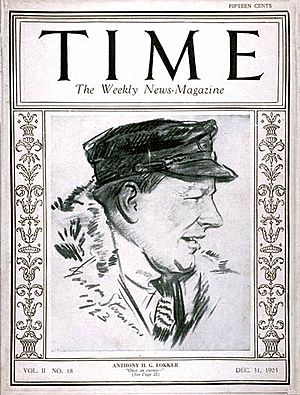
Around 1926 or 1927, Fokker moved to the United States. There, he started the North American part of his company, called the Atlantic Aircraft Corporation. His planes became well-known for daring flights by pilots.
- The Fokker F.VII aircraft was used by pilot Richard E. Byrd and machinist Floyd Bennett. They flew over or near the North Pole on May 9, 1926.
- In June 1928, Amelia Earhart crossed the Atlantic to Wales in a Fokker F.VII/3m trimotor.
- In 1930, Charles Kingsford Smith flew around the world in another Fokker F.VII.
However, the company's reputation was hurt in March 1931. The famous University of Notre Dame football coach Knute Rockne was killed in the crash of a Fokker F.10A.
Fokker's Dutch and American companies were very successful in the late 1920s. But he lost some control when the company went public to sell shares. In 1929, General Motors took over Fokker Aircraft Corporation of America. They merged it into the General Aviation Corporation. Fokker became the director of engineering. He left in 1931. Fokker's designs became less modern, and in 1934, General Aviation stopped making them. However, they were still built in the Netherlands.
Anthony Fokker died at age 49 in New York in 1939. He passed away from pneumococcal meningitis after being sick for three weeks. In 1940, his ashes were brought to Westerveld Cemetery in Driehuis, North Holland. They were buried in his family's grave.
Fokker was recognized for his contributions to aviation.
- In 1970, he was inducted into the International Air & Space Hall of Fame.
- In 1980, he was inducted into the National Aviation Hall of Fame in Dayton, Ohio.
Fokker in Popular Culture
Anthony Fokker's nickname was The Flying Dutchman. He has been shown in movies and TV shows.
- Hurd Hatfield played him in the 1971 film Von Richthofen and Brown.
- The character Roy Fokker from the animated series Super Dimension Fortress Macross was named after Anthony Fokker and Roy Brown.
- Craig Kelly played Fokker in Young Indiana Jones Chronicles: Attack of the Hawkmen.
One of KLM's Boeing 747-200s was named after Fokker. It flew for the airline from 1979 to 2004.
See also
 In Spanish: Anthony Fokker para niños
In Spanish: Anthony Fokker para niños
- Jan Hilgers
- Vecihi Hürkuş


